| Srl | Item |
| 1 |
ID:
139185
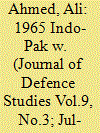

|
|
|
|
|
| Summary/Abstract |
This article seeks to analyse the lessons of the 1965 Indo-Pak war that are applicable today. It finds that the current army doctrine, Cold Start, has some similarities to the opening round of the 1965 war. It argues that even the attritionist strategy adopted in 1965 may have more to give today than the manoeuvre war approach of its more famous successor, the 1971 war. In particular, the article appraises Prime Minister Lal Bahadur Shastri’s firm political control during the war and finds that it was ably reinforced by the prime ministers who were at the helm in India’s later wars. Knowing when to stop is key to avoiding nuclear thresholds, and in that the 1965 war, which stopped short of decisive victory, serves as a suitable precedent to potential future conflicts.
|
|
|
|
|
|
|
|
|
|
|
|
|
|
|
|
| 2 |
ID:
094155
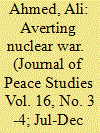

|
|
|
| 3 |
ID:
116351
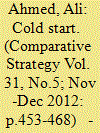

|
|
|
|
|
| Publication |
2012.
|
| Summary/Abstract |
India's conventional war doctrine has been extensively discussed over the past decade. It has been dubbed Cold Start, though the term has been dropped from usage recently. The article discusses India's limited-war doctrine in its origin, impetus behind it, tenets, and reasons for the current distancing from the doctrine. The doctrine was India's rekindling of its conventional deterrent in the face of Pakistani subconventional proxy warfare. Its implications in terms of escalation possibilities to the nuclear level attracted considerable attention. Its "quick on the draw" nature added to concerns on crisis stability. These conspired to shift the latest doctrinal movement in India away from default reliance on traditional conventional operations to a proactive strategy that includes in addition punitive military response options.
|
|
|
|
|
|
|
|
|
|
|
|
|
|
|
|
| 4 |
ID:
100957


|
|
|
|
|
| Publication |
2010.
|
| Summary/Abstract |
The Cold Start doctrine is an innovative exercise. While Cold Start discusses how to start the campaign, equal thinking needs to attend how to end it. On the conventional level, the learning is that the Cold Start offensives of the integrated battle groups need to be delinked from those of the strike corps. Plausible political aims cannot be visualised that make nuclear risk of launch of strike corps offensives worth running. On the nuclear front, fallout of the scenario considered is on the doctrine of 'massive' nuclear retaliation. This has its limitations in reacting to nuclear strikes of low opprobrium quotient. Moving to 'flexible' nuclear retaliation countenancing ending an exchange at the lowest possible level may be preferable instead. In the nuclear age, utility of military force has reached its limits. The future lies in energising non-military problem solving approaches.
|
|
|
|
|
|
|
|
|
|
|
|
|
|
|
|
| 5 |
ID:
128130
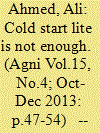

|
|
|
|
|
| Publication |
2013.
|
| Summary/Abstract |
In the wake of the Kargil War, India developed a limited war doctrine. The key elements of this doctrine are that is a proactive and offensive. It is proactive in the sense that while being strategically reactive, for instance to terror provocation emanating from Pakistan, it is proactive at the operational level in choosing the time and place of conventional response and shaping of the battle. It is offensive in terms of its intent of taking the battle to the enemy, fighting on and making gains on enemy territory and its aim plus of punishing the Pakistan military.
|
|
|
|
|
|
|
|
|
|
|
|
|
|
|
|
| 6 |
ID:
104853


|
|
|
| 7 |
ID:
098319
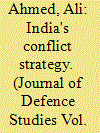

|
|
|
|
|
| Publication |
2010.
|
| Summary/Abstract |
Continued engagement with LOAC and IHL is ongoing with the Judge Advocates
General Department taking the primary role. Its training institution in Kamptee
is at the forefront. There has been increased interaction with the ICRC since
India opened up to the ICRC in the mid nineties, after initially being defensive
with respect to Kashmir. Not only has IHL been introduced into officer and
subordinate ranks courses, but guest lectures are also organised. Increased
scope of the engagement is possible, particularly if it finds mention in the next
edition of the Army doctrine. Increasing the scope of adherence to IHL, such as
by acceding to AP I and the ICC, can be debated. Even if India remains outside,
it can be expected that it would follow the tenets as a responsible power.
|
|
|
|
|
|
|
|
|
|
|
|
|
|
|
|
| 8 |
ID:
127877
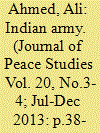

|
|
|
| 9 |
ID:
101643
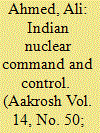

|
|
|
| 10 |
ID:
113611
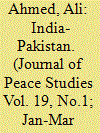

|
|
|
| 11 |
ID:
140421


|
|
|
| 12 |
ID:
101726
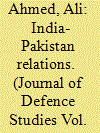

|
|
|
| 13 |
ID:
133927


|
|
|
|
|
| Publication |
New Delhi, Routledge, 2014.
|
| Description |
xviii, 240p.Hbk
|
| Standard Number |
9781138019706
|
|
|
|
|
|
|
|
|
|
|
|
Copies: C:2/I:0,R:0,Q:0
Circulation
| Accession# | Call# | Current Location | Status | Policy | Location |
| 057877 | 355.020954/AHM 057877 | Main | On Shelf | General | |
| 057928 | 355.020954/AHM 057928 | Main | On Shelf | General | |
|
|
|
|
| 14 |
ID:
132794
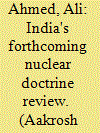

|
|
|
|
|
| Publication |
2014.
|
| Summary/Abstract |
A nuclear doctrine review is on the cards. The BJP having promised in its manifesto that it will conduct a review would likely follow through, in the least to keep up its credibility The last review was done in 2003, when the earlier NDA government adopted the official nuclear doctrine. It is believed that the official, declaratory nuclear doctrine was largely based on the Draft Nuclear Doctrine of I999. While the UPA government that followed did not review (read or revise) the doctrine, this does not imply that it did not keep the doctrine under review. The National Security Advisory Board (NSAB), convened for two years, is tasked to review national security and, as part of this. can be expected to have engaged with nuclear questions. Its output has been kept confidential. Besides, the six monthly meetings of the Executive Council of the Nuclear Command Authority have found mention in the media. Therefore, it will only be fair to acknowledge that a lack of transparency on this score does not imply inaction. It can be inferred from the fact that the declaratory doctrine has not been revised that the UPA government. in both its tenures. either did not think it necessary to revise the doctrine or may have revised the operational nuclear doctrine even while keeping the declaratory nuclear doctrine in place and intact.
|
|
|
|
|
|
|
|
|
|
|
|
|
|
|
|
| 15 |
ID:
123325
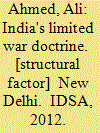

|
|
|
|
|
| Publication |
New Delhi, IDSA, 2012.
|
| Description |
91p.Pbk
|
| Series |
IDSA Monograph Series No.10
|
| Standard Number |
9789382169093
|
|
|
|
|
|
|
|
|
|
|
|
Copies: C:2/I:0,R:0,Q:0
Circulation
| Accession# | Call# | Current Location | Status | Policy | Location |
| 057419 | 355.020954/AHM 057419 | Main | On Shelf | General | |
| 057420 | 355.020954/AHM 057420 | Main | On Shelf | General | |
|
|
|
|
| 16 |
ID:
087618


|
|
|
|
|
| Publication |
2009.
|
| Summary/Abstract |
India has demonstrated restraint and maturity in wake of bothe the Parliament and the Mumbai attacks. It has not allowed the calibration of its policy to be hijacked by war hysteria.
|
|
|
|
|
|
|
|
|
|
|
|
|
|
|
|
| 17 |
ID:
093157


|
|
|
| 18 |
ID:
102234
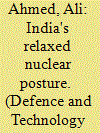

|
|
|
| 19 |
ID:
098048
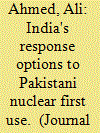

|
|
|
| 20 |
ID:
094050


|
|
|